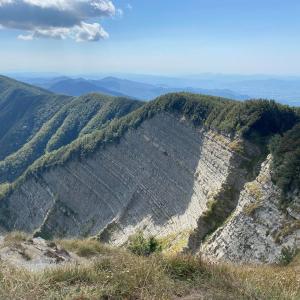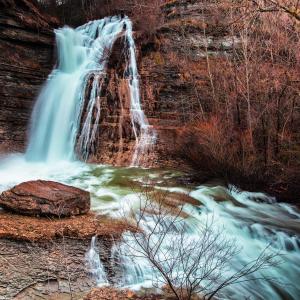Welcome to Badia Tedalda A journey to the source of the Marecchia river, where Romagna meets Tuscany. Discover the nature, Robbia terracotta and unique gastronomy.
“The time of nature is not the time of civilisation. It is the time of the nightingale, the river, peace and ecstasy”.
(Quote by F. Caramagna)
Travelling up the Marecchia river to its source, you cross Romagna on its border with Tuscany, eventually reaching the slopes of Mount Zucca, set in the heart of a dense beech forest in Badia Tedalda, 930 metres above sea level.
This is where the Marecchia river has its origin. Before flowing into the Adriatic, it traverses 70 km of land, giving its name to the valley through which it flows.
Our journey starts right here, at the source of a river that crosses a landscape characterised by ravines and clay marl soils.
Along the route leading to the source of the Marecchia, you will encounter the Fonte di Dante, a little stream where the legendary poet is said to have rested to quench his thirst while travelling to Romagna at the request of Uguccione della Faggiola.
The source is located in a protected area of natural interest called Nuclei di Taxus Baccata di Pratieghi. Here you will find a circular nature trail that encompasses the whole of the protected area.
Here, nature reigns supreme, as you can see from the Alpe della Luna circular trail. You can reach it by road from Badia Tedalda, along the road leading from the river towards Monteviale, then park the car and set off on a wonderful 17-kilometre walk, which takes almost six hours.
Although the trek is quite demanding, it takes you past crystal-clear pools and steep rocky walls, through an unspoilt landscape which is also connected to several myths and legends.
The scenery is extremely varied; the path is lined with young saplings alternating with ancient oaks, along a trail that takes you to the remains of the Gothic Line.
Once at Ripa della Luna you find yourself on top of the best-known rockface in this nature reserve—you’ll be impressed by the sheer drop, which looks as though the rock has been sliced by a knife. From this panoramic spot you can enjoy the view of the Ripa, and gaze across the whole of the Marecchia valley. The rocks Simone and Simoncello and the nearby Carpegna are easy to spot.
You can continue - with a small detour - as far as the “Specchio della Luna” (“Mirror of the Moon”), a small lake which in itself is worth the effort of the long hike.
This little corner of paradise is a long way from other more popular hiking trails—you will be amazed at its primordial beauty. Although you might feel like getting your feet wet, the water is freezing cold and you’ll want to put your shoes on again quickly!
From the northern slopes of the Alpe della Luna comes the river Presalino - which forms the Presalino waterfall at the point where it meets the Presale river. The waterfall is about 1.5 km from the centre of Badia Tedalda.
The Presalino Waterfall is not just a stunning natural phenomenon, it is also an important landmark, being the gateway to the northern side of the nature reserve thanks to a footpath that takes you to the slopes of Alpe della Luna.
The natural landscape of this area may be splendid, but there’s a lot more you need to see. Our trip to Badia Tedalda continues with the Della Robbia terracotta sculptures—tangible signs of the close political, cultural and commercial relations forged with the city of Florence from the late 15th until the mid-16th century.
The Church of St Michael Archangel is where you will find the carefully-preserved glazed ceramics produced by the brothers Santi and Benedetto Buglioni, who studied with the master sculptor Luca Della Robbia. The works, commissioned by the bishop Leonardo Bonafede, are magnificent: three large altar pieces, an elegant tabernacle depicting angels and cherubs, and two figures in bas-relief, portraying the angel Gabriel appearing to Mary.
In the Church of St Thomas of Montebotolino there is another Robbia masterpiece, depicting the Incredulity of the saint. The scene engraved on the altarpiece shows Jesus blessing the disbelieving Thomas as he touches the wound in the side of the Messiah. There are another five tiles below the altarpiece.
Finally, in the Church of Saints Peter and Paul in Fresciano you can see the terracotta work depicting The Delivery of the Keys to St. Peter.
After so much beautiful art, nature and culture, your journey continues at the dinner table.
As Badia Tedalda is a border town, the cuisine is rich and varied. Although the food here is based on the rural farming tradition and features humble ingredients, there are plenty of seasonal surprises awaiting you.
In addition to the excellent Chianina PGI beef, from cattle reared in the unspoilt pastures around Badia Tedalda, other typical local specialities are to be found in the woods. Seasonal mushrooms include ‘prugnoli’ and ‘porcini’, while the truffle varieties are the Scorzone, Nero Pregiato and Tartufo Bianco. All of them make the perfect sauce ingredient for homemade pasta: tagliatelle, ricotta and spinach ravioli, cappelletti, potato gnocchi or passatelli.
One of the traditional dishes you might want to try is the ‘panzanella’ (a summer version of ribollita soup), Tuscan-style chicken-liver crostini, sausages in oil, ‘raviggiolo’ (fresh cheese made from raw cow’s milk), grilled potato cakes or ‘migliaccio’ (semolina pie).

